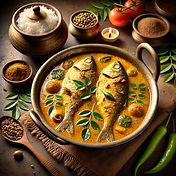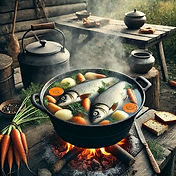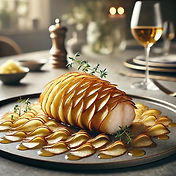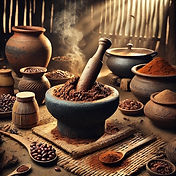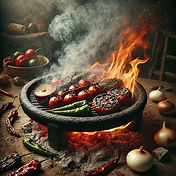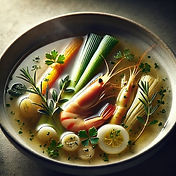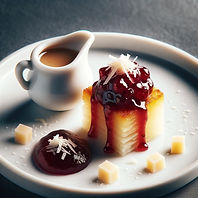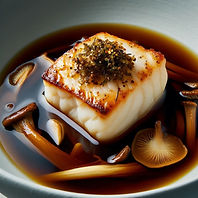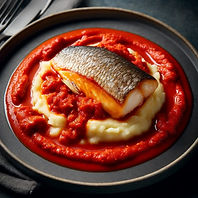Top Chef ™: Wisconsin
Season:
Week:
Personal Growth

Kristen Kish: "Final elimination challenge here in Wisconsin? We want you to take a look back on your time here and give us a dish that shows us how you've grown as a chef. Was there a breakthrough or an aha moment, or is there a dish that you know you'd crush now that you didn't early on? We've seen you grow so much these last many weeks. We want to see that on the plate."
"Obviously, this is the dish that's going to really determine who's moving on to the finals. Take all these experiences, what you've learned as a chef, and get it onto that plate. Put it all out there."
"So today, you'll each get $150 to shop at a specialty store. You'll then have $200 to shop at Whole Foods Market. Tomorrow, you'll have 3 hours to prep and cook at Paul's restaurant, Harbor House. You'll be serving a table of local chefs, some that you might recognize."

Get recipes ...
Subscribe to our weekly recipes and culinary tips from streamed cooking shows.
Dishes prepared in
Top Chef ™: Wisconsin
Savannah: "I made potato pave, chicken sauce reduction, and a jam made of burnt onion and cherry. I think that potatoes have everything that they naturally need to make a pave. We just have to add heat and pressure, and so heat and pressure of this competition, I realized I naturally had everything I needed. I just needed these experiences to bring it out."
Judges: "Well said."
Kristen Kish: "That's probably one of the best deliveries and explanations of edition I've ever heard."
Judge: "She's very articulate, very thoughtful, great storyteller."
Judge: "And to make a pave in that amount of time, that's hard."
Judge: "And it's a nice pave. It does take a lot of guts to use the pave as the star of the plate."
Judge: "And I just adored the sauce, the cherries, and the caramelization of the onions. I just thought it was a lovely pairing, and I feel like storytelling is the thing that separates good food from exceptional food. I love a potato pave, and I love it even more now that Savannah told us why she made a potato pave."
"It shows growth. I mean, that's it."
"No question."
Manny: "So I have a snapper, a la Veracruzana with creamed potatoes and saltines. Just because that's a way that I will eat it back home. I wanted to reach back to my roots, which is when I have felt the most comfortable in this competition. I want to make sure I keep honoring the cuisine of my people."
Judges: "Great. Thank you, Manny."
Guest Judge: "Delicious. You know, the fish is beautifully cooked. I like the little tartness of the tomato, the creaminess of the potato. I think it's good."
Tom Colicchio (shaking his head in ardent disagreement): "Not even close. The fish is raw."
Another judge: "Mine's not cooked either."
Yet another judgeL "Really? Oh, no. Mine's, like just right."
"Yours is beautiful. Mine is beautiful. Like, literally spot on."
"Mine's perfect."
"I think when you do a dish that's this seemingly simple, all of the details matter."
"I'm happy that he showed us something that was personal to him. There is a piece of me that wonders, did he fit the dish to the story or the story to the dish? I think Manny's dish has nothing to do with the journey in Wisconsin at all."
Tom Colicchio: "It's a good dish. Potatoes are nice and creamy. It's just, that's a pretty major flaw."
Laura: "This is Lamb Manti, an eastern Mediterranean pasta. I made a barbacoa, blended that with a little bit of guajillo and some tomatoes. Usually on my dishes, I was putting too many components that were not making too much sense. Top Chef actually taught me how to do it in a more focused way."
Judges, bheind the scenes ...
"The dumpling pasta is pure love."
"Yeah."
"The pasta and the lamb inside is a delicious bite."
"I appreciate the guajillo in there. I like the balance that it had."
"Her dish is focused. Her plating is beautiful."
"It's really hard to overlook the technique behind her dish."
"It's good. It's really delicious."
Danny: "I made a soba cha mushroom broth with mushroom puree, cod, and a little furikake on top."
Gail Simmons: "So what's the inspiration behind this?"
Danny: "There's kind of two points. One, just to redeem myself a little bit for the terrible tea that I served you at restaurant wars. And then subtle dishes typically get lost here in the top chef kitchen. So I wanted to do what I interpret as a subtle dish with a lot of nuanced flavors."
(Judges, eating, look at each other.)
Judge: "So you think this is subtle?"
Danny: "I think it has some restraint to it. Yes."
Judges (behind the scenes) ...
"It's not subtle. Nothing subtle."
"It's a good dish, but it's clearly not subtle."
"I love the Japanese aspect of it. I love the way that the furikake brings the ocean back into the fish, but I'm not necessarily reading the tea aspect of the dish."
"You know, if tea's gonna be your main point on this storytelling, why isn't it just swimming in this, like, gorgeous bath of tea? I mostly tasted the mushroom."
"The fish was just sort of lost."
"The fish is buried in a lot of big flavor. Yeah, that said, it's a good miss."
Dan: "My dish here is smoked walleye, lemongrass, turmeric, brown butter emulsion, potato dumplings, and then some herbs. Basically, my growth here is I was learning to just cook from a sense of place, and that's the backbone of this dish is all about Wisconsin. And then from there, I refuse to put myself in a box. Therefore, I love the idea of global influence with stuff like turmeric. I just went for it."
Judges, behind the scenes ...
"Absolute maximalist."
"Yes."
"It's a lot of everything, but many of these elements work."
"I love smoke. But I'm finding that all I'm eating is smoke."
"I like the contrast in that smoky flavor to the richness and depth of the broth. But it needed something fresh. It was really heavy for me."
"It feels to me like the story and the dish from Dan were a little bit muddled."
"I'm not getting turmeric, I'm not getting lemongrass. But the flavor that's there is good. There's just a lot going on. It's really suffering from an identity crisis. "
Culinary Challenges inspired by
Top Chef ™: Wisconsin
Ajika is a vibrant, aromatic spice blend originating from the Caucasus region, particularly Georgia and Abkhazia. This fiery condiment combines the heat of red chili peppers with aromatic herbs like fenugreek, coriander, and dried mint, along with garlic and walnuts for richness and depth. Traditional ajika is prepared by grinding dried chilies with fresh herbs, garlic, salt, and sometimes nuts into a coarse paste. The resulting blend offers an intense, complex flavor profile that's simultaneously spicy, herbaceous, and slightly tangy. Used as a marinade, condiment, or cooking ingredient, ajika adds bold character to meats, vegetables, and stews, bringing the distinctive flavors of the Caucasus to your kitchen.
Pirozhki are traditional Eastern European hand pies, particularly beloved in Russian cuisine. These small, portable delights feature a soft, pillowy yeast dough wrapped around savory or sweet fillings. Classic savory versions contain ground meat with onions, cabbage with eggs, or potato with mushrooms, while sweet variations might feature fruit preserves or sweetened farmer's cheese.
To make pirozhki, a yeast dough is prepared, allowed to rise, then divided into small portions. Each portion is flattened, filled with the prepared filling, sealed into an oval or crescent shape, and then either baked until golden or fried until crispy. They're perfect for meals on the go or as comforting appetizers.
Fried kielbasa is a delicious preparation of traditional Polish smoked sausage that transforms this hearty meat into a crispy, flavorful dish. When sliced and pan-fried, the kielbasa develops a caramelized exterior while maintaining its juicy, savory interior. The cooking process releases its garlicky, smoky flavors and renders some of the fat, creating a perfect balance of textures. Home cooks appreciate kielbasa for its versatility - serve it alongside eggs for breakfast, tuck into sandwiches for lunch, or pair with sauerkraut and potatoes for a comforting dinner. It's also excellent cut into bite-sized pieces and served as an appetizer with mustard for dipping.
Aji amarillo is a vibrant yellow-orange chili pepper native to Peru, considered the cornerstone of Peruvian cuisine. With a medium heat level and distinctive fruity flavor profile that hints at mango and sunshine, it delivers warmth without overwhelming spiciness. Home cooks can find aji amarillo as fresh peppers, frozen, dried, or in convenient paste form, which is most commonly available in international markets. This versatile pepper brings both color and depth to classic dishes like papa a la huancaína (potato with cheese sauce), ceviche, and aji de gallina (creamy chicken stew). Its unique taste can transform ordinary sauces, marinades, and dips into something memorably flavorful.
Jeera, commonly known as cumin seeds in English, is a staple spice in many South Asian, Middle Eastern, and Mediterranean cuisines. These small, oblong seeds come from the Cuminum cyminum plant and have a warm, earthy flavor with slight citrus notes. In Indian cooking, jeera is often the first spice added to hot oil or ghee (a process called "tempering") to release its aromatic oils. It's an essential ingredient in spice blends like garam masala and adds depth to curries, rice dishes, lentils, and vegetable preparations. Jeera also has digestive benefits and is sometimes consumed as a tea to aid digestion after heavy meals.
Meen Moilee is a celebrated Kerala fish curry that exemplifies South Indian coastal cuisine. This luxurious dish features firm white fish gently poached in a velvety coconut milk sauce infused with aromatic spices. The preparation begins by sautéing curry leaves, green chilies, ginger, and onions until fragrant, then adding turmeric, ground spices, and coconut milk to create a golden, creamy base. The fish is carefully added last, allowing it to cook just until tender. The hallmark of Meen Moilee is its balanced flavor profile - mild heat complemented by tanginess from tomatoes or sometimes vinegar, sweetness from coconut milk, and brightness from fresh lime juice. Served with rice, this curry represents the perfect harmony of Kerala's abundant seafood and tropical ingredients.
Ukha is a traditional Russian clear fish broth that dates back centuries, revered for its clean, delicate flavors. This aromatic soup begins by gently simmering whole fish—typically freshwater varieties like pike, perch, or sturgeon—with minimal vegetables and aromatics, allowing the pure essence of the fish to shine through.
The preparation is deliberately simple: fish, onions, carrots, bay leaves, black peppercorns, and occasionally potatoes or leeks. What distinguishes ukha is its clarity—the broth should remain transparent, never cloudy. Often finished with fresh herbs like dill or parsley and a splash of vodka, authentic ukha embodies Russian cuisine's philosophy of highlighting natural flavors rather than masking them with excessive seasonings.
Pommes de terre en écailles, meaning "scaly potatoes" in French, is an elegant potato preparation technique that transforms the humble tuber into a sophisticated side dish. Thin-sliced rounds of peeled potatoes are meticulously arranged in overlapping patterns resembling fish scales or roof tiles in a buttered dish. Each layer is brushed with melted butter and seasoned with salt and pepper before the next is added. The assembled potatoes are then baked until the edges turn wonderfully crisp while the centers remain tender.
The result is a visually striking dish with beautiful textural contrast—crispy, golden exterior scales protecting creamy interiors—that elevates any meal with its refined presentation and rich buttery flavor.
Dawadawa is a traditional West African fermented seasoning made primarily from locust beans (Parkia biglobosa), though occasionally from soybeans or other legumes. The preparation begins by boiling the beans until soft, then pounding them to remove the seed coats. The cleaned seeds are boiled again, spread out, and covered with leaves to ferment naturally for 2-3 days. This fermentation process develops a pungent aroma and complex, umami-rich flavor profile. The resulting black paste is typically shaped into balls or patties for storage. Used as a flavor foundation in soups, stews, and sauces across Ghana, Nigeria, and other West African countries, dawadawa adds remarkable depth and nutritional value to countless dishes.
You can buy dawadawa spice here.
Pipian is a rich, traditional Mexican sauce that exemplifies the complexity of pre-Hispanic cuisine. Made from ground pumpkin or squash seeds (pepitas), this velvety sauce incorporates various chiles, spices, and sometimes nuts or seeds like sesame or peanuts. The ingredients are toasted, ground into a paste, and simmered with broth until thickened to a smooth consistency. Pipian can range from vibrant green (pipian verde) to deep red (pipian rojo), depending on the chiles used. Commonly served over poultry or pork, this sauce offers a nutty, earthy flavor profile with subtle heat that showcases Mexico's remarkable ability to balance complex flavors into harmonious dishes.
Tatemado is a traditional Mexican cooking technique most commonly associated with Jalisco cuisine. This slow-cooking method involves placing ingredients—typically meat such as pork, goat, or beef—into clay pots that are partially buried in hot coals or placed in an underground pit oven. The pots are sealed with masa (corn dough) to trap moisture and smoke, allowing the meat to cook gently for several hours until incredibly tender. This process imparts a distinctive earthy flavor while preserving the meat's natural juices.
Tatemado dishes are often seasoned with regional spices, chiles, and herbs, creating complex flavor profiles that showcase Mexico's rich culinary heritage. The result is meltingly tender meat with unparalleled depth of flavor.
Nage, pronounced "nahj," is a fragrant, aromatic broth used in French cuisine primarily for poaching seafood and vegetables. This delicate liquid is typically created by simmering wine, water, or fish stock with aromatic vegetables (onions, celery, fennel) and herbs. After cooking, the ingredients may be strained out, and the remaining liquid can be reduced and enriched with butter to create a "beurre monté" sauce.
The term 'nage' is also used to describe dishes cooked in this liquid—referred to as "à la nage"—resulting in light, flavorful preparations that highlight the natural taste of the main ingredient while infusing it with subtle complexity.











